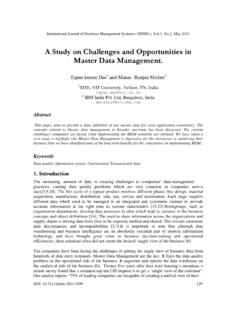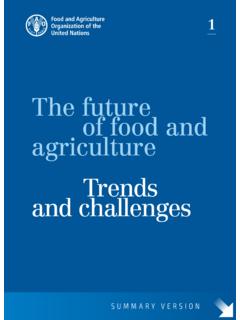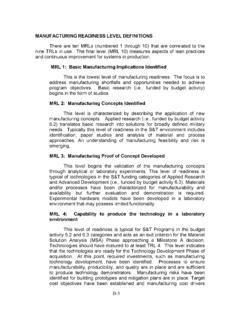Transcription of Challenges and opportunities for carbon sequestration in ...
1 Challenges and opportunitiesfor carbon sequestrationin grassland systemsA technical report on grassland management and climate change mitigationISSN 1020-4555 Integrated Crop Management Vol. 9 2010 Prepared for the Plant Production and Protection DivisionFood and Agriculture Organization of the United Nations (FAO)Compiled byRichard T. ConantColorado State UniversityFort Collins, United States of AmericaFood ANd AgrICUltUre orgANIzAtIoN oF the UNIted NAtIoNS Rome, 2010 Challenges and opportunities for carbon sequestration in grassland systemsA technical report on grassland management and climate change mitigationIntegrated Crop Management Vol. 9 2010the designations employed and the presentation of material in this information product do not imply the expression of any opinion whatsoever on the part of the Food and Agriculture organization of the United Nations (FAo) concerning the legal or development status of any country, territory, city or area or of its authorities, or concerning the delimitation of its frontiers or boundaries.
2 The mention of specific companies or products of manufacturers, whether or not these have been patented, does not imply that these have been endorsed or recommended by FAo in preference to others of a similar nature that are not 978-92-5-106494-8 All rights reserved. FAo encourages reproduction and dissemination of material in this information product. Non-commercial uses will be authorized free of charge. reproduction for resale or other commercial purposes, including educational purposes, may incur fees. Applications for permission to reproduce or disseminate FAo copyright materials and all other queries on rights and licences, should be addressed by e-mail to or to the Chief, Publishing Policy and Support Branch, office of Knowledge exchange, research and extension, FAo, Viale delle terme di Caracalla, 00153 rome, Italy. F A O 2 0 1 0 Cover photos, from left to right: r. Conant, , FAo/J.
3 Prontz, 9 2010iiiCoNteNtS v133577141519202323242526272829303133333 535384951 Executive summary ChApteR 1 IntroductionChApteR 2 BackgroundGrasslands cover broad areas, contribute substantially to livelihoods and are vulnerable Grasslands are intensively used and degradation is widespread ChApteR 3 OpportunitiesCarbon sequestration in grasslands Reduced carbon emissions through reduced grassland degradationPractices that sequester carbon in grasslands often enhance productivityPractices that sequester carbon in grasslands can enhance adaptation to climate changePotential income for practices that sequester carbon ChApteR 4 ChallengesDeveloping workable policies and incentives is difficult Demonstrating additionality is a formidable challenge carbon sequestered in grassland systems is subject to reversals Well-intentioned policies do not necessarily lead to good practices Land tenure and governance issues complicate policy implementation Systems for documenting carbon stock changes have not been agreed uponPractice-based estimates of soil carbon sequestration Combining
4 Measurement with mechanistic modelling Data on management impacts on carbon stocks are limited in developing countries ChApteR 5 The way forward Foundations for sound policies Grassland carbon sequestration in context Research prioritiesRefeRenCesACknowledgementspoli Cy bRiefVol. 9 2010vexeCUtIVe SUMMAryImplementing grassland management practices that increase carbon uptake by increasing productivity or reducing carbon losses ( through high rates of offtake) can lead to net accumulation of carbon in grassland soils sequestering atmospheric carbon dioxide (CO2). Globally, the potential to sequester carbon by improving grassland practices or rehabilitating degraded grasslands is substantial of the same order as that of agricultural and forestry sequestration . Because practices that sequester carbon in grasslands often enhance productivity, policies designed to encourage carbon sequestering grassland management practices could lead to near-term dividends in greater forage production and enhanced producer income.
5 Practices that sequester carbon in grasslands also tend to enhance resilience in the face of climate variability, and are thus likely to enhance longer-term adaptation to changing climates. Developing policies to encourage the adoption of practices that sequester carbon has several significant Challenges , such as demonstrating additionality, addressing the potential for losses of sequestered carbon , and engaging smallholders and pastoralists with uncertain land tenure. In addition, the paucity of data in developing countries hampers the measurement, monitoring and verifying of carbon sequestration in response to those practices. This report reviews the current status of opportunities and Challenges for grassland carbon sequestration . Based on these observations, the report then identifies components that could foster the inclusion of grasslands in a post-2012 climate agreement, and the development of policies to improve grassland management.
6 S. redFerNVol. 9 20101 ChApteR 1 IntroductionThe implementation of improved land management practices to build up carbon stocks in terrestrial ecosystems is a proven technology for reducing the concentration of carbon dioxide (CO2) in the atmosphere offsetting emissions from other sources and drawing down atmospheric CO2. Developing effective policies capable of growing terrestrial carbon sinks is a serious challenge. Grassland carbon sequestration faces the same Challenges as those relating to forestry and agricultural sequestration , but in some ways they are greater. sequestration rates can be slower, the ability to measure change could be more difficult, benefits may be distributed across more landowners/land managers with less certain tenure, practices may be more varied, costs of implementation are more poorly quantified, and the scientific information to inform policy analysis is less complete.
7 The opportunities to benefit from grassland practices that sequester carbon can be greater too. The large populations of people who depend directly on grasslands tend to be poor and vulnerable to climate variability and climate change. Implementing practices to build or rebuild soil carbon stocks in grasslands could lead to considerable mitigation, adaptation and development benefits. However, the discussion of grassland carbon sequestration has lagged behind that of agriculture and forestry; forestry is an important, existing component of the Clean Development Mechanisms (CDM) of the Kyoto Protocol. This report discusses the Challenges that grassland sequestration faces and the substantial and diverse opportunities that arise with management practices that lead to carbon sequestration in grasslands. The report concludes by identifying key knowledge barriers and deriving a set of recommended activities and observations that can overcome them.
8 FAo/d. MIllerVol. 9 20103 ChApteR 2 BackgroundGRAsslANDs COveR BROAD AReAs, CONTRIBUTe sUBsTANTIAlly TO lIvelIhOODs AND ARe vUlNeRABleGrasslands, including rangelands, shrublands, pastureland, and cropland sown with pasture and fodder crops, covered approximately billion ha in 2000, representing 26 percent of the world land area and 70 percent of the world agricultural area, and containing about 20 percent of the world s soil carbon stocks (FAOSTAT, 2009; Ramankutty et al., 2008; Schlesinger, 1977). People rely heavily upon grasslands for food and forage production. Around 20 percent of the world s native grasslands have been converted to cultivated crops (Figure 1) (Ramankutty et al., 2008) and significant portions of world milk (27 percent) and beef (23 percent) production occur on grasslands managed solely for those purposes. The livestock industry largely based on grasslands provides livelihoods for about 1 billion of the world s poorest people and one-third of global protein intake (Steinfeld et al.)
9 , FAO, 2006). GRAzING lANDsWoodlandShrublandtall grassMedium grassShort grassSource: Connant and Paustian, 2000 Integrated Crop Management4 Challenges ANd opportunities For carbon sequestration IN grASSlANd SySteMSA teChniCAl RepoRt on gRAsslAnd mAnAgement And ClimAte ChAnge mitigAtionThe development Challenges faced by the populations of the world s dry grasslands systems vividly illustrate the tightening linkage between ecosystem services and enhanced human well-being: 2 billion people inhabit dryland regions, yet dryland regions have only 8 percent of the world s renewable water supply. This means that people have access to water that meets only two-thirds of the minimum per capita requirements, population growth rates are faster in drylands than anywhere else, but production potential is lower than anywhere else. Traditional socio-ecological systems have evolved to cope with climatic and economic uncertainty, but population and economic pressures are increasingly taxing traditional systems (Verstraete, Scholes and Stafford Smith, 2009).
10 Primary production in rangelands is relatively low, varies substantially from place to place, and is strongly limited by precipitation (Le Houerou, 1984). Even where rainfall is high (some grassland areas receive as much as 900 mm of precipitation per year), almost all of the precipitation falls during distinct rainy seasons and evapotranspiration demands exceed precipitation during most of the year. Moreover, precipitation, and thus production, varies considerably from year to year, with coefficients of variation averaging 33 percent, and as high as 60 percent in some of the drier areas (Ellis and Galvin, 1994). Grasslands are thus highly vulnerable to climate change (Thornton et al., 2007; 2009).figuRe 1: Percentage of native grassland/savannah and shrubland that has been converted to cropland and pasture Source: ramankutty et al., 2008 CroPlANdPAStUreS AmericaN AmericaPacific (development)europeAsia (incl.)
















